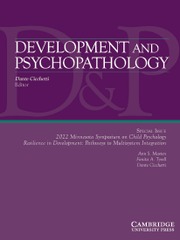Article contents
A multilevel prediction of physiological response to challenge: Interactions among child maltreatment, neighborhood crime, endothelial nitric oxide synthase gene (eNOS), and GABA(A) receptor subunit alpha-6 gene (GABRA6)
Published online by Cambridge University Press: 04 November 2015
Abstract
Physiological response to stress has been linked to a variety of healthy and pathological conditions. The current study conducted a multilevel examination of interactions among environmental toxins (i.e., neighborhood crime and child maltreatment) and specific genetic polymorphisms of the endothelial nitric oxide synthase gene (eNOS) and GABA(A) receptor subunit alpha-6 gene (GABRA6). One hundred eighty-six children were recruited at age 4. The presence or absence of child maltreatment as well as the amount of crime that occurred in their neighborhood during the previous year were determined at that time. At age 9, the children were brought to the lab, where their physiological response to a cognitive challenge (i.e., change in the amplitude of the respiratory sinus arrhythmia) was assessed and DNA samples were collected for subsequent genotyping. The results confirmed that complex Gene × Gene, Environment × Environment, and Gene × Environment interactions were associated with different patterns of respiratory sinus arrhythmia reactivity. The implications for future research and evidence-based intervention are discussed.
- Type
- Regular Articles
- Information
- Development and Psychopathology , Volume 27 , Special Issue 4pt2: Multilevel Developmental Perspectives on Child Maltreatment , November 2015 , pp. 1471 - 1487
- Copyright
- Copyright © Cambridge University Press 2015
References
- 8
- Cited by


